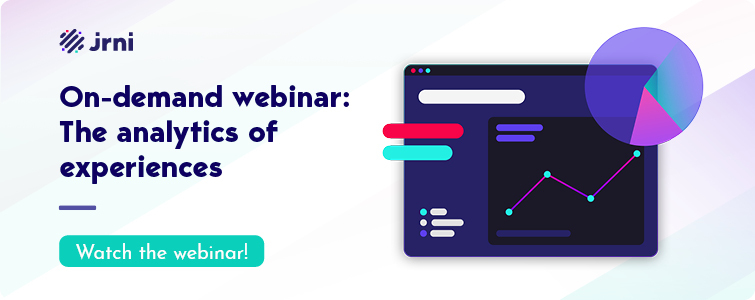What a year it’s been (said no one everyone ever)! And while you’re probably beyond ready to dive into 2021, there’s one last thing you need to do this year: review your experiential relationship management (XRM) analytics. Reviewing your XRM analytics is not only crucial to help you understand and measure success over the past year, it’s going to be instrumental in setting up future goals.
Now, unfortunately, analytics gets a bad reputation for being complex and overwhelming. While it’s true there is always an endless amount of data to analyze, it doesn’t mean you need to drown in your data. Reviewing your analytics data will help you understand what worked, what didn’t work, and where to go from here - empowering you to make important business decisions. By focusing on some key metrics from this past year, you will be able to translate this vital data into actionable insights. So here are the five key things you should review in your 2020 analytics:
1. Revenue and conversion rate
We’ll start with the obvious! If you truly want to track your success from the year, you’ll need to review how much revenue was generated and your conversion rate. This is going to show you the true value of your XRM strategy, and how impactful your experiences are on your organization’s bottom line. How much revenue is being generated through each customer engagement? How many conversions do you have from offering these experiences? By reviewing this data, you will be able to identify successes and areas for improvement. Analyzing your revenue and conversion data will help you answer important questions such as:
- What services are most valuable to your organization?
- How can you expand these services or capitalize on this success in the future?
- What regions or locations performed best?
- Were there certain services offered in top-performing locations that you should offer elsewhere?
- Which staff members are driving the most conversions and/or bringing in the most revenue?
- What are your top-performing staff members doing well? Can you train your other employees to use their method to be more successful?
There are some powerful insights you can draw from reviewing your revenue and conversion rates. Additionally, you can use this year’s successes to set up goals for next year!
2. Seasonal trends
Well, it’s fair to say that your seasonal trends might have looked a little different this year - but identifying these trends is still crucial! In fact, this might be one of the most important areas to review this year due to the evolving behavior of consumers during the pandemic. By honing in on seasonal trends, you can identify low-performing and high-performing times throughout the year using date comparisons. This can help you allocate the proper resources during popular times, and identify ways to maximize revenue during slower times.
For example, maybe you’re a store that offers dress-fitting appointments and these appointments are a major revenue driver for your business. Maybe the appointments were more scattered throughout this year versus last, but you still saw a spike from May to August. Some questions you could ask about this data:
- Were you properly staffed for the increase in dress-fitting appointments?
- Were your marketing campaigns aligned with the timing of this trend?
- Could you do more to promote this personalized experience next year?
- What can you do better next year to be fully prepared for this seasonal trend?
Similarly, banks also see trends with their experiences. For example, maybe your bank used to see a lunchtime rush across branches, but that’s changed since COVID-19. You should reevaluate the heavily trafficked times at your branch locations, asking questions such as:
- What were the busiest times at your branch locations?
- Did you have enough experienced staff on hand to meet with customers during these busy times?
- How long did customers with a pre-booked appointment have to wait?
- How can you prepare for busier times next year to minimize wait time and improve the customer experience?
Again, it’s likely that COVID-19 impacted your seasonal and business trends this year, but this could give you insight into what “normal” will continue to look like in upcoming years. Tracking seasonality can be complex, but by leveraging this crucial information, you can ensure you’re offering the right services at the right time, and are properly staffed.
3. Appointment status
With 57% of consumers more likely to book an appointment now due to the pandemic, and 41% saying the human touch is an integral part of their shopping experience, appointments are a critical component of your XRM strategy. That’s why it’s important to review your appointment status data from 2020. How many appointments were completed and how many were no-shows? This is a great way to give you insight on what types of appointments are working better for your business and how to reduce no-shows. Here are some important questions to consider when reviewing your appointment status data:
- Are there certain types of appointments that result in more no-shows?
- What appointment types have the highest percentage of completion?
- Which completed appointment types are driving the most conversions?
- How can you reduce the number of no-show appointments?
- Do you have an automated way to send out reminders? Do you need to send out additional appointment reminders?
- Is it easy for customers to cancel an appointment?
- Did your cancellation policy leave enough time to reschedule your staff or fill the void?
- Did you offer a virtual appointment as an option for someone who canceled an in-person appointment (if it makes sense for the service type)? Or should you offer this in the future?
As you can see, there are a lot of things to consider and many ways you can improve. By reviewing your 2020 appointment status data, you will have an idea of what you need to do to set yourself up for success in 2021.
4. Lead time and wait time
Lead time and wait time are both essential when it comes to providing an exceptional experience. If either are too long, it can lead to a loss in revenue and customer loyalty. So you better believe in the importance of looking at these metrics!
Lead time is the amount of time in advance a customer needs to book one of your services. If the lead time is too long, a consumer might go to a competitor. It’s critical to identify what lead time is acceptable and how you can staff your locations to ensure minimal lead times.
Wait time is the elapsed time between a customer’s arrival and the actual appointment. Having a minimal wait time is vital because aside from wanting personalized, one-on-one experiences, consumers book appointments to avoid waiting. Through your analytics, you can evaluate how long your customers are waiting to see a staff member. If your wait times in 2020 were fairly short, that’s great! But you can still use this data to improve. Ideally, customers who pre-book an appointment would never have to wait. That’s not going to be 100% possible, but certainly is something to aim for!
Analyzing your lead and wait times will help you identify areas for improvement and will give you an idea on how to staff for your various experiences.
5. Staff capacity
Finally, you should review staff capacity as a key indicator of your success in 2020. After all, by having the proper amount of staff and the right staff available, you can improve the customer experience. Were your in-store locations and branches properly staffed throughout the year?
You can look at this data to see which locations are overstaffed and which locations are understaffed - and work toward a better balance across all locations. Don’t underestimate the importance of proper staffing and the direct impact it has on customer satisfaction. After all, 86% of buyers will pay more for a great customer experience. By ensuring enough staff members are available to assist your customers, you can simultaneously improve the staff and customer experience.
And there you have it! By knowing what to look at and look for, you and your teams can use your XRM analytics to track success, identify operational efficiencies and areas for improvement, and enhance the customer experience. Here’s to using the power of data to make your 2021 better than ever!
If you want to learn more, check out our on-demand webinar: “The analytics of experiences”. You will learn more about what kinds of experience data you need and how JRNI Analytics can empower you and your teams to reach new levels of success! Additionally, you can watch a demo of JRNI Analytics here to learn more!




